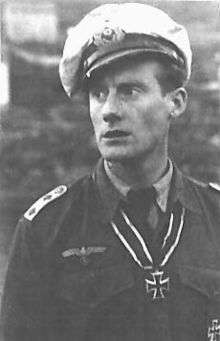Paul Brasack
| Paul Brasack | |
|---|---|
 | |
| Born |
9 May 1916 Stettin |
| Died |
11 March 2013 (aged 96) Bad Pyrmont |
| Allegiance |
|
| Service/branch |
Luftwaffe (to 1942) |
| Years of service |
1937–42 1957–74 |
| Rank |
Kapitänleutnant (Wehrmacht) Kapitän zur See (Bundesmarine) |
| Unit |
SSS Gorch Fock Schlesien cruiser Köln KG 3 "General Wever" U-590 |
| Commands held |
U-737 Destroyer Zerstörer 2 (D171) |
| Battles/wars | |
| Awards | Knight's Cross of the Iron Cross |
Paul Brasack (9 May 1916 – 11 March 2013[1]) was a Kapitänleutnant with the Kriegsmarine during World War II and commander of U-737. He was born in Stettin. He was also a recipient of the Knight's Cross of the Iron Cross (German: Ritterkreuz des Eisernen Kreuzes). The Knight's Cross of the Iron Cross was awarded to recognise extreme battlefield bravery or successful military leadership.
As commander Brasack was not credited with sinking any ships. His U-boat was part of a wolf pack which operated against Convoy JW 56A and Convoy JW 56B. He fired at the destroyer HMS Milne on 31 January 1944, but missed, the torpedo exploded in the destroyers wake. His actions against the convoys pulled off the escorting destroyers enabling other U-boats of his wolf pack to attack. For these actions he was awarded the Knight's Cross.
Following World War II, Brasack joined the Bundesmarine of the Federal Republic of Germany on 1 October 1957. He commanded the destroyer Zerstörer 2 (D171) (formerly USS Ringgold (DD-500)) from September 1962 until March 1964. From 15 September 1968 to 1 September 1971 he served as naval attaché at the German Embassy in Washington, D.C..
Summary of career
Awards
- Observation Badge (28 February 1940)[2]
- Front Flying Clasp of the Luftwaffe for Combat Pilots in Gold[2]
- Ehrenpokal der Luftwaffe (24 June 1941)[2]
- Iron Cross (1939)
- U-boat War Badge (1939) (24 September 1942)[2]
- U-boat Front Clasp in Silver
- Knight's Cross of the Iron Cross on 30 October 1944 as Kapitänleutnant and commander of U-737[4][5]
- Legion of Merit (10 October 1972)[3]
Promotions
| Kriegsmarine | |
|---|---|
| 1 April 1938: | Fähnrich zur See (Officer Cadet)[2] |
| 1 July 1939: | Oberfähnrich zur See (Senior Ensign)[2] |
| 1 August 1939: | Leutnant zur See (Second Lieutenant)[2] |
| 1 September 1941: | Oberleutnant zur See (First Lieutenant)[2] |
| 1 July 1944: | Kapitänleutnant (Captain Lieutenant)[3] |
| Bundesmarine | |
| 1 October 1957: | Korvettenkapitän (Corvette Captain)[3] |
| 24 April 1961: | Fregattenkapitän (Frigate Captain)[3] |
| 25 July 1968: | Kapitän zur See (Captain at Sea)[3] |
References
Citations
- ↑ http://trauer-dewezet.de/24897278
- 1 2 3 4 5 6 7 8 9 10 Busch & Röll 2003, p. 486.
- 1 2 3 4 5 6 7 Busch & Röll 2003, p. 487.
- ↑ Scherzer 2007, p. 240.
- ↑ Fellgiebel 2000, p. 143.
Bibliography
- Busch, Rainer; Röll, Hans-Joachim (2003). Der U-Boot-Krieg 1939–1945 — Die Ritterkreuzträger der U-Boot-Waffe von September 1939 bis Mai 1945 [The U-Boat War 1939–1945 — The Knight's Cross Bearers of the U-Boat Force from September 1939 to May 1945] (in German). Hamburg, Berlin, Bonn Germany: Verlag E.S. Mittler & Sohn. ISBN 978-3-8132-0515-2.
- Fellgiebel, Walther-Peer (2000) [1986]. Die Träger des Ritterkreuzes des Eisernen Kreuzes 1939–1945 — Die Inhaber der höchsten Auszeichnung des Zweiten Weltkrieges aller Wehrmachtteile [The Bearers of the Knight's Cross of the Iron Cross 1939–1945 — The Owners of the Highest Award of the Second World War of all Wehrmacht Branches] (in German). Friedberg, Germany: Podzun-Pallas. ISBN 978-3-7909-0284-6.
- Scherzer, Veit (2007). Die Ritterkreuzträger 1939–1945 Die Inhaber des Ritterkreuzes des Eisernen Kreuzes 1939 von Heer, Luftwaffe, Kriegsmarine, Waffen-SS, Volkssturm sowie mit Deutschland verbündeter Streitkräfte nach den Unterlagen des Bundesarchives [The Knight's Cross Bearers 1939–1945 The Holders of the Knight's Cross of the Iron Cross 1939 by Army, Air Force, Navy, Waffen-SS, Volkssturm and Allied Forces with Germany According to the Documents of the Federal Archives] (in German). Jena, Germany: Scherzers Militaer-Verlag. ISBN 978-3-938845-17-2.
External links
- Helgason, Guðmundur. "Paul Brasack". German U-boats of WWII - uboat.net. Retrieved 28 September 2013.
- "Paul Brasack". Lexikon der Wehrmacht (in German). Retrieved 28 September 2013.
| Military offices | ||
|---|---|---|
| Preceded by Fregattenkapitän Otto Ites |
Commander of German destroyer Zerstörer 2 (formerly USS Ringgold) October 1962 – March 1964 |
Succeeded by Fregattenkapitän Mumm |